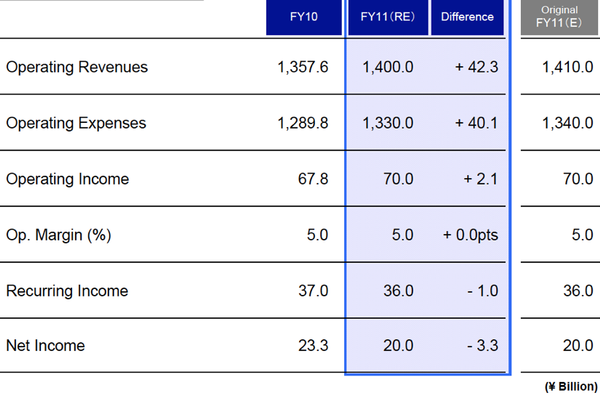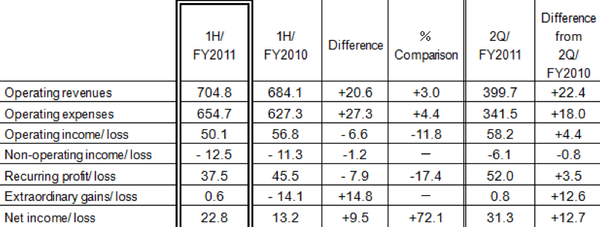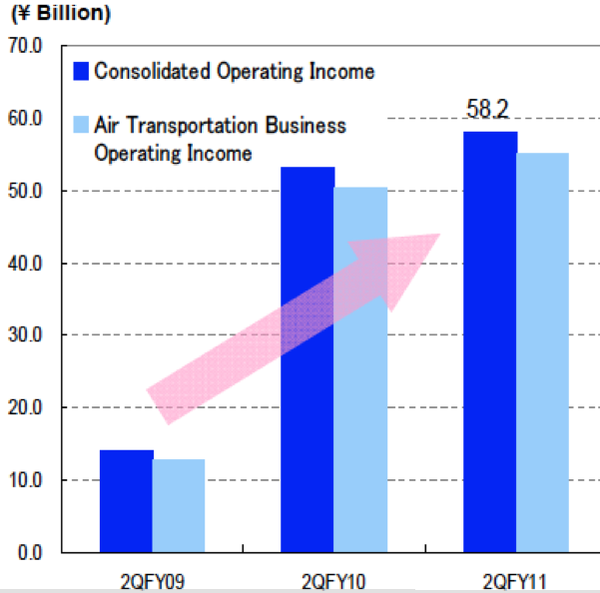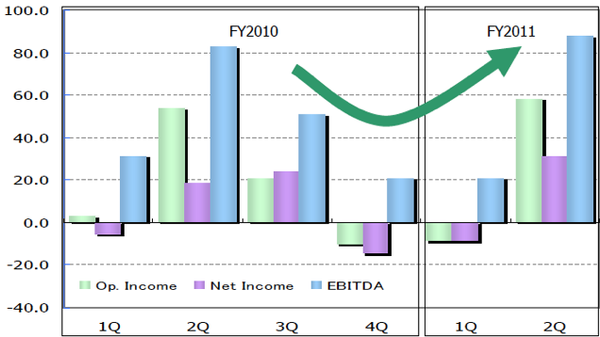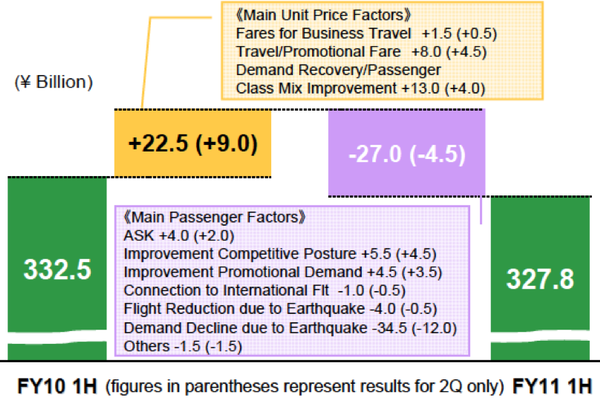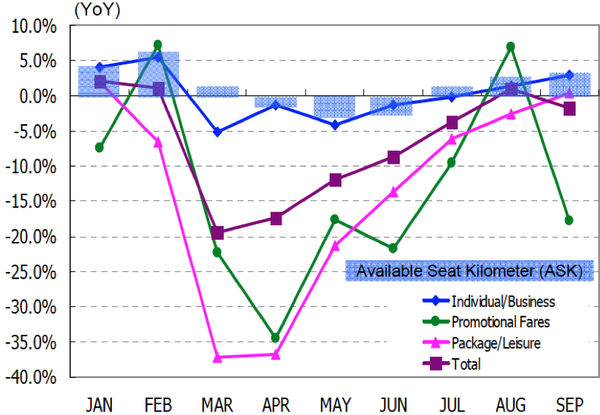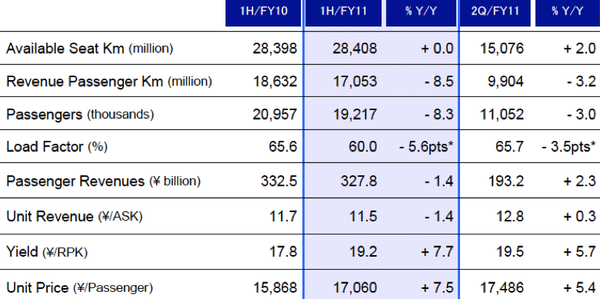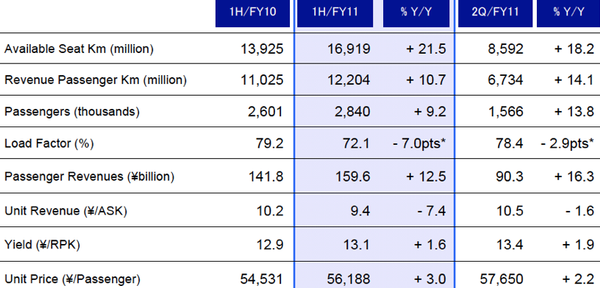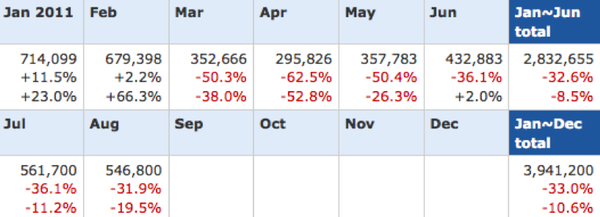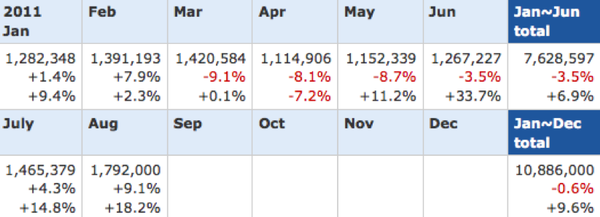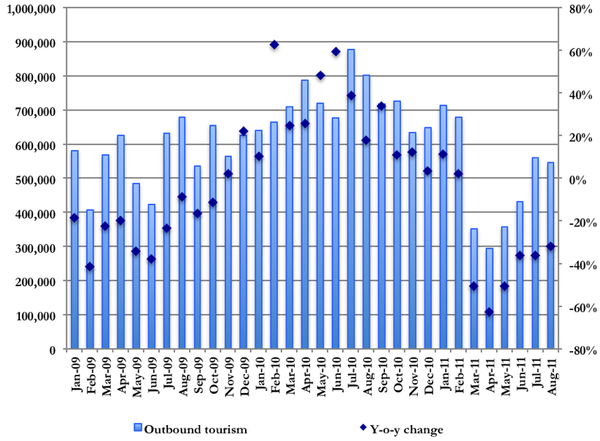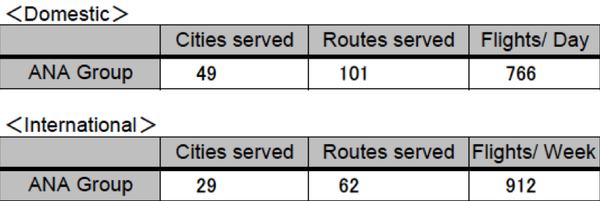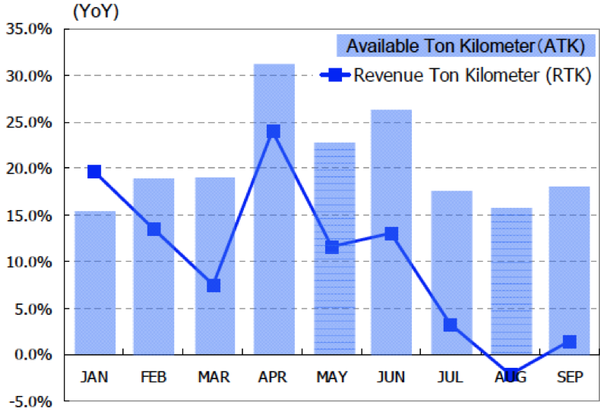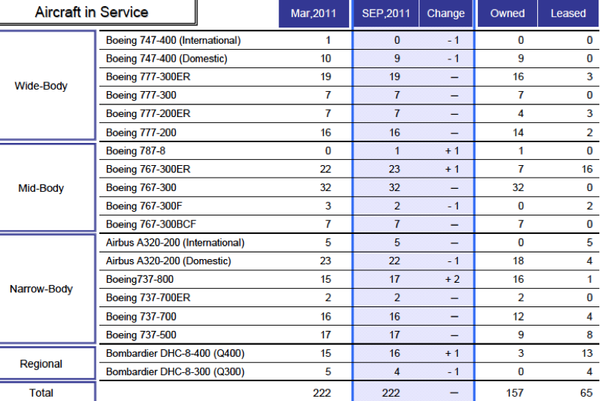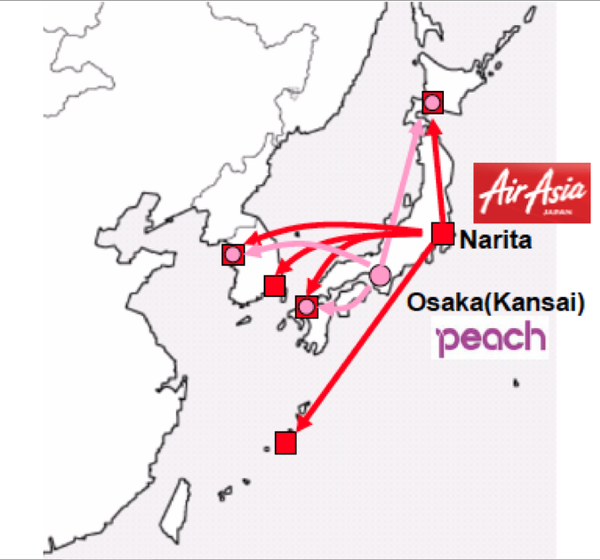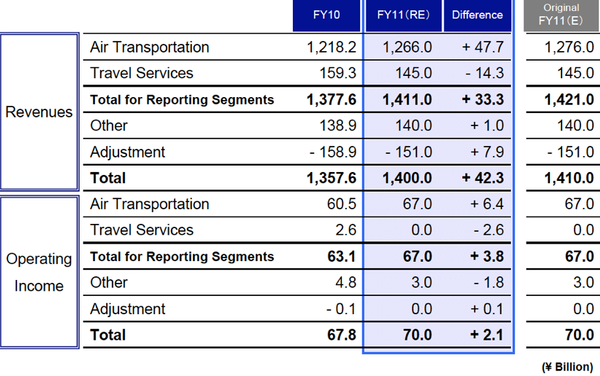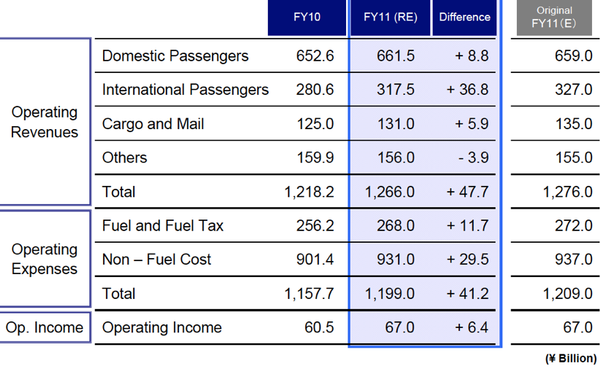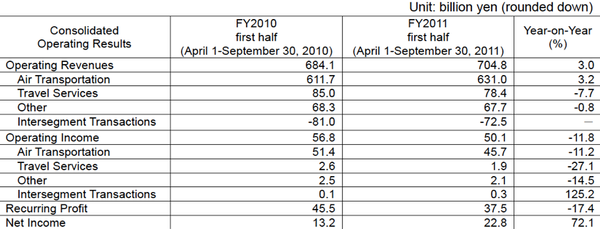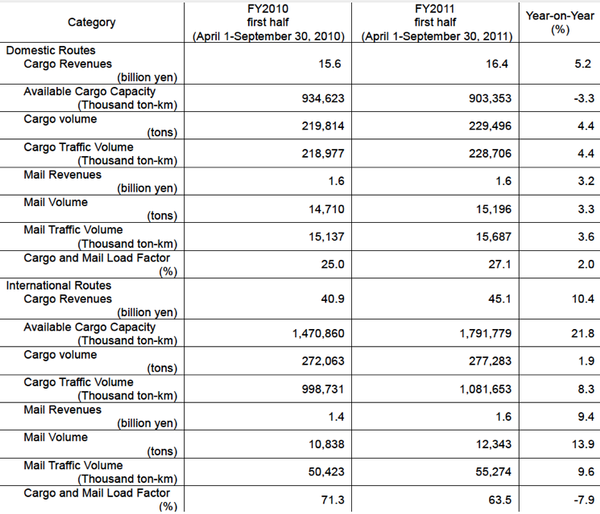ANA operating profit weakens in 1HFY2011 with FY2011 revenue outlook downgraded
All Nippon Airways (ANA), Japan's largest airline group and Asia's largest publicly listed carrier, reported 11.8% reduction in operating profit to JPY50.1 billion (USD641 million) but a 72% jump in net profitability in 1HFY2011 (six months to 30-Sep-2011) to JPY22.9 billion amid a recovery in demand and a steady increase in business and tourism demand following the 11-Mar-2011 earthquake, tsunami and nuclear disaster. The second quarter also saw strong quarter-on-quarter gains after the past 11-Mar-2011 slump, which saw the carrier report a JPY8.4 billion net loss in the three months to 30-Jun-2011.
Citing concerns about weakness in its own and key global economic markets, stubbornly high oil prices, softening domestic demand and the impact of the strong yen, ANA lowered its full-year sales forecast from an earlier estimate of JPY1.41 trillion to JPY1.40 trillion, which would mark a 3.1% year-on-year revenue increase.
The airline, however, left its full-year net profit target of JPY20 billion (USD26 million) unchanged, effectively forecasting a loss in 2HFY2012 (six months to 31-Mar-2012), and marking a 14.2% year-on-year reduction in full-year net profitability. Operating profit is expected to be up 3.2% year-on-year in the full-year to JPY70 billion (USD92 million).
"Performance during the first half has for the most part been on track. However, the outlook for the second half of the fiscal year remains unclear due to factors such as world economic trends, concerns about recession in Japan and overseas, and the impact of exchange rates. The short-term outlook remains unclear due to factors such as the weakening global economy, steep rises in crude oil prices, and volatility in exchange rates and equity markets," ANA cautioned.
Consolidated operating results forecast for the financial year ended 31-Mar-2012
The first half was a busy one for ANA, which established AirAsia Japan on 31-Aug-2011 and took delivery of its first B787 on 31-Aug-2011 ahead of its launch on regular services on 01-Nov-2011. The carrier also introduced a number of initiatives to stimulate and aid in the recovery of demand from the effects of the Great East Japan Earthquake on 11-Mar-2011 and continued its JPY30 billion (USD384 million) efficiency programme to minimise the impact on revenues.
Net profit growth of 72% in first half with record 2Q2011 operating profits
In the six months ended 30-Sep-2011, ANA reported a net profit of JPY22.8 billion (USD302 million), a 72.1% year-on-year increase, as a recovery in international demand offset continued weakness in the domestic market in the aftermath of the 11-Mar-2011 earthquake and tsunami. Recurring profits weakened 17.4% to JPY37.5 billion (USD480 million). While operating profits increased 72% to JPY50.1 billion (USD641 million), operating profit margins weakened 1.2 ppts to 7.1 ppts and EBITDA margin was down 1.3 ppts to 15.4%.
ANA consolidated operating results (JPY bill): Six months ended 30-Sep-2011
Meanwhile, the carrier reported a historically high operating profit of JPY58.2 billion (USD745 million) in 2QFY2011.
ANA operating income: 2QFY2011 (Jul-Sep)
Operating profit, net profit and EBTIDA results (JPY bill): 2QFY2011
Revenue growth of 21% in 1HFY2011
In the first half, operating revenues increased 3.0% year-on-year to JPY704.8 billion, outpaced by a 4.4% increase in operating expenses to JPY654.7 billion. International passenger revenue increased 12.5% to JPY159.6 billion amid the demand recovery, capacity increases, demand stimulation measures and increased fuel surcharges, outpacing a 1.4% weakening in domestic passenger revenue to JPY327.8 billion, as the Japanese economy continued to struggle from the impact of 11-Mar-2011 and subsequent events.
International revenue change factors: 1HFY2011
Domestic revenue change factors: 1HFY2011
Domestic demand yet to recover
During 1H2011, ANA reported an 8.5% year-on-year reduction in domestic traffic (RPKs) on flat capacity, resulting in a 5.6 ppt load factor reduction to 60%.
ANA monthly capacity (ASKs) trends: Jan-2011 to Sep-2011
ANA has worked to stimulate domestic demand amid the "rapid decline" in demand, with the carrier noting that "we achieved a certain level of success" with these measures and the rate of declines has lessened since Jul-2011, although a "full recovery has not been seen yet". Meanwhile, business domestic demand has shown signs of recovery from Apr-2011 and has "tended on par" with previous year levels since Jun-2011.
Meanwhile, domestic unit revenue (RASK) weakened 1.4% to JPY11.5 (USD 14.72 cents), while yield increased 7.7% to JPY19.2 (USD 24.57 cents) and unit price increased 7.5% to JPY17,060 (USD218).
ANA domestic passenger service results: Six months ended 30-Sep-2011
International passenger demand shows signs of revival from mid Apr-2011
International traffic for the six-month period increase 10.7%, outpaced by a 21.5% increase in capacity, resulting in a 7 ppt load factor decline to 72.1%. Overall unit revenue (RASK) weakened 7.4% to JPY9.4, while yield increased 1.6% to JPY13.1 and unit price increased 3.0% to JPY56,188.
Passenger services, driven by business demand, began to show signs of revival from around mid-Apr-2011, despite the marked declines seen in the month immediately following the earthquake. Business demand has subsequently "rebounded to nearly the same level as the same period last year in June," the carrier said. In terms of international leisure demand, outbound demand has been "firm" since Jul-2011, while inbound demand will likely "take time to recover from the considerable decline in demand for inbound tourist from overseas", the carrier expects.
ANA international passenger service results: Six months ended 30-Sep-2011
According to Japan National Tourist Organization, international visitor numbers to Japan have weakened 33.0% to 3.9 million in the eight months to Aug-2-11 and are down 10.6% from 2009 levels. Outbound tourism levels have weakened 0.6% year-on-year to 10.9 million but have increased 9.6% from 2009 levels.
Statistics of overseas visitors to Japan
Statistics of visitors from Japan travelling overseas
Japan inbound tourism: Jan-2009 to Aug-2011
Japan outbound tourism: Jan-2009 to Aug-2011
Cost-cutting efforts also contributed to the carrier's results as it sought to minimise the impact of the quake-tsunami with demand stimulating initiatives and a JPY30 billion (USD384 million) efficiency programme. In the wake of the disasters, the airline reduced services on some sectors and deployed smaller aircraft to meet the post-earthquake demand declines. The carrier also introduced a number of domestic and international marketing campaigns designed to stimulate demand, and has been adding capacity back into the market on routes where demand has strengthened over recent months. The carrier also launched its trans-Pacific JV on 01-Apr-2011 with United Continental.
Pushing ahead with international expansion
ANA, which deploys only around 13.3% of its seats internationally, is now firmly focused on pushing ahead with its international expansion plans. Japan Airlines' (JAL) brutal network contractions make the going easier and the lethargic nature of the domestic economic recovery all encourage outward looking strategies for ANA.
Other external factors are prodding the carrier in its expansion mode too, such as the recent capacity increase in slots at Tokyo Haneda and Narita airports, the delivery of the B787s, a series of JVs with its alliance partners - notably the "metal neutral" antitrust immunity it received for trans-Pacific operations with United Continental following the landmark open skies agreement between Japan and the US - and a newly approved partnership with Lufthansa from the winter 2011 schedule, have opened the door wide for ANA to expand. This breakthrough development was facilitated by the approval, on 01-Jun-2011, of what was the first Asian-European antitrust immunity.
Membership in the Star Alliance since Oct-1999 has also delivered substantial benefits, now being exploited more effectively through deeper coordination with its alliance partners. This has provided strong additional domestic connections, opened up new capacity through codeshare opportunities and significantly boosted ANA's network and revenue potential.
ANA's focus on expanding its network through alliances and JVs will allow US services to increase from 125 cities in FY2010 to 310-330 cities in FY2012 through agreements with United, Air Canada and TAM. Asian services will increase from 59 to 80-85 cities through agreements with Singapore Airlines, Asiana, Air China and Thai Airways, and Europe services will increase from 60 to 70-75 cities through agreements with Lufthansa, SWISS and Austrian Airlines, as a result of the JV with Lufthansa.
Coinciding with the B787 deliveries, ANA is also taking advantage of the increased number of slots at Tokyo Haneda it believes will further enhance its competitiveness and provide the opportunity to regain international travellers from its Asian rivals. Tokyo Haneda Airport is ANA's "biggest source of revenue", having undergone a once-in-a-generation expansion in 2010 as a new fourth runway opened for the winter 2010/11 schedule. ANA president Shinichiro Ito in Oct-2011 stated services to/from Haneda are generally full and transfers from domestic to international services at the airport are increasing. Tokyo Narita stated ANA has reported average load factors of 81% since the opening of the airport's fourth runway and new international passenger terminal on 21-Oct-2011.
See related article: Airlines charging a premium for services from Tokyo Haneda Airport
ANA operated a total network of 49 domestic and 29 international cities as at Sep-2011.
ANA network: at Sep-2011
Cargo revenue and traffic improves
Cargo volumes on domestic routes increased 4.4% year-on-year in the six-month period as the demand to carry goods on air routes instead of land transport increased after the earthquake, especially to Hokkaido. The carrier also benefited from an increase in maximum takeoff weight to on-par with ANA takeoff weight, on codeshares services with Hokkaido International Airlines since Jul-2011. This negated a reduced supply of cargo bellyhold space as a result of reduced domestic capacity.
ANA cargo results: Six months ended 30-Sep-2011
International cargo volumes saw "good growth" in the first half of around 1.9% despite being affected by the impact of the earthquake on the supply chain for automotive components in particular and reduced demand from Japan to the US and Europe as domestic companies curbed exports amid disrupted production. However, a quicker than expected recovery in production and increased air freight capacity as Tokyo Haneda Airport made the transition to an international airport resulted in an 1.9% year-on-year increase in international cargo volumes.
ANA monthly trends in international cargo
Overall, domestic cargo revenues increased by 5.2% year-on-year, while revenues on international cargo increased 10.4% year-on-year.
ANA cargo operations revenue change factors: 1H2011
ANA commences service with 'game changing' B787
Key to ANA's future strategy and cost-reduction efforts is the introduction of B787 equipment. Boeing claims the B787 consumes 20% less fuel than comparable planes, an attractive proposition for airlines facing soaring fuel costs. ANA has labelled the aircraft "a game-changing aircraft" marking a "new horizon for aviation and the company", with Mr Ito stating the carrier has "great hope that it will significantly boost our business".
The carrier is also hopeful the deployment of the B787 will help stimulate demand, with Mr Ito stating the carrier is targeting overseas customers as competition in the domestic market intensifies. "The 787 is said to be a game changer and it will allow us to expand our network," Mr Ito has said. By the end of Mar-2012, ANA is expected to further expand its international B787 network, with routes to US and/or Europe from Tokyo Haneda, rather than Narita, Japan's traditional long-haul gateway. The international route plan is part of ANA's drive to become Asia's largest international carrier, senior executive vice president Mitsuo Morimoto said. ANA surpassed JAL as Japan's largest international carrier by the end of FY2010.
ANA operated its maiden commercial service of the long-delayed B787 on 26-Oct-2011 on the Tokyo Narita-Hong Kong sector. Scheduled services featuring the B787 will commence on 01-Nov-2011 to domestic Japanese destinations including Haneda-Okayama and Haneda-Hiroshima (by the end of this fiscal year, the aircraft will be successively used on routes connecting Haneda with Itami, Yamaguchi-Ube, and Matsuyama) followed by the first long-haul service, with weekly Tokyo Haneda-Beijing service from Dec-2011 through Jan-2012. This will be followed by the first long-haul international service on 21-Jan-2012 with services between Tokyo Haneda and Frankfurt. Services will operate three times weekly initially, increasing to daily service from 01-Feb-2011. The new route will complement ANA's four existing European services from Narita to Frankfurt, Munich, London and Paris.
Mr Ito said he plans to use the deployment on its European routes in the future, with the carrier also examining the US West Coast as a potential destination for its new B787 equipment. Mr Ito has also alluded to Switzerland and Belgium as some of the next destinations under consideration.
ANA has ordered 55 B787s from Boeing and has already received two aircraft (powered by twin Rolls-Royce Trent 1000 engines), with a total of 20 slated for delivery by the end of FY2012 (Mar-2013). Nine B787s are expected at the carrier before the end of Mar-2012, one less than previously expected. The initial 11 B787s deliveries, through 2011 and 2012, will reportedly be financed with funding from the Japan Bank for International Cooperation (JBIC).
The B787s will eventually help ANA save JPY10 billion p/a (USD130 million) through fuel savings, the carrier has forecast. However, Mr Ito said that with just two newly delivered aircraft, it was still too early to determine the exact fuel performance of the aircraft, which ended up heavier than originally designed. "We don't expect a substantial gap between performance and expectations but this is the first aircraft and we are examining the performance but need more time," Mr Ito said.
ANA has configured its long-haul international B787s with 158 seats across two cabins. The exceptionally low-density configuration can be attributed to 46 business seats (fully flat Sicma Skylounge business class seats) configured in spacious alternating rows of 1-2-1 and 1-1-1 (compared to a typical 2-2-2 or even 1-2-1 throughout configuration) and the 112 seats in economy (33 to 34 inch seat pitch) arranged in a standard eight-abreast 2-4-2 configuration instead of the nine-abreast option available to airlines and which Boeing uses as a "typical" configuration. ANA executive VP Keisuke Okada said the airline would be interested in any stretched version of the B787. Boeing has not yet decided if it will launch a second stretched version of the aircraft, which it refers to as the -10 variant. ANA's initial regional and domestic B787s will be configured with 264 seats (12 Sicma Majesty business class seats and 252 economy), the densest B787 configuration confirmed to date, which will be reduced to a 222-seat configuration for regional services.
See related articles:
- JAL continues low-density 787 configuration trend with plan for 186 seats
- Boeing Dreamliner delivery to ANA begins 787's Asia-Pacific dominance
- Beijing and Frankfurt to be first international Boeing 787 destinations for ANA
The carrier had a total fleet of 228 aircraft as at 31-Aug-2011.
ANA Group fleet as of 30-Sep-2011
Entering the LCC game
ANA has also finally made the plunge to establish not one but two LCCs. Peach Aviation will be based in Kansai Airport, where ANA has a limited network. It took years of deliberation to spawn "Peach" but seemingly only moments after the announcement, ANA said it would also establish a low-cost joint venture with AirAsia, "Japan AirAsia", to operate out of Narita Airport. It had taken five years to get to Peach and only a twinkling to progress to AirAsia, evidence of how rapid the LCC market is developing in North Asia.
Peach Aviation and AirAsia Japan proposed route networks
The subsequent confusion suggested that unusual competitive forces were at play - in this case an imminent tie-up between AirAsia and Japan's third airline, Skymark, which has pretensions to become a major force in the market. Despite clarifications about the compatibility between the two new subsidiaries, there was clearly no initial strategy to establish two such similar operations. ANA has only agreed to a 33.4% stake in Peach, the consequence of having to tread carefully with its unions, yet the AirAsia JV has ANA holding 67% and AirAsia 33%.
Mr Ito stated he hopes the launch of two ANA-affiliated LCCs will create new demand for air travel in the market. "We would like to create more opportunities for customers, including those who have never used airplanes to fly by setting up two companies that are totally different from the ANA brand, from a perspective of generating new aviation demand," Mr Ito said.
Despite having a clear goal of lowering costs to half the levels of network carriers, Peach will face an uphill battle in Japan, where high landing fees and personnel costs have prevented genuinely low-cost operations. AirAsia by contrast has many options for keeping costs low, with bases across lower-cost Asian countries. Many sensitive nerves have been disturbed by these developments and it will take ANA some time to navigate the issues raised. Meanwhile, both AirAsia and Peach Aviation will face competition from JAL-Jetstar Group JV, Jetstar Japan.
Start-up plans for Peach and AirAsia Japan
ANA - Japan's quiet achiever
To much of the outside world, ANA is Japan's quiet achiever. Privately owned and again profitable, ANA has in the past been overshadowed by its more conspicuous competitor and flag carrier, Japan Airlines - until now. While JAL has been struggling back to its feet after its stint in bankruptcy protection, ANA has picked up the mantle, overtaking JAL as Japan's dominant carrier, proving itself a versatile and dynamic competitor in the wider Asian market, as well as domestically.
ANA is now looking internationally, with plans to use its new B787 aircraft and Tokyo Haneda as a springboard to become the leading airline in Asia amid a shrinking domestic market. The carrier, the 11th largest airline carrier in the world by passenger numbers, expects to report an operating profit of JPY70 billion (USD92 million) and a net profit of JPY20 billion (USD26 million) in the full year on sales of JPY1.4 trillion.
Consolidated operating results forecast for the financial year ended 31-Mar-2012
Operating results forecast for the financial year ended 31-Mar-2012
Operating results forecast for the financial year ended 31-Mar-2012
Looking longer term, ANA is targeting revenues of JPY1.5 trillion by FY2014 on operating income of JPY150 billion. The carrier also hopes to reduce operating costs by JPY100 billion, equivalent to JPY1 per unit cost, with the ultimate aim of improving its competitive financial position. Tokyo Haneda will play a key role.
ANA Group new corporate plan
However, ANA like every other carrier, has stated that the outlook for 2HFY20111 remains unclear due to factors such as world economic trends, concerns about recession in Japan and overseas, and the impact of exchange rates. This will have a negative impact on operating revenue expectations, which are expected to fall around JPY10 billion (USD128 million) compared with figures announced on 29-Jul-2011, despite performance being "on track" in the first half. The carrier, however, noted that continued efforts to cut costs are expected to reduce operating expenses by the same amount, fully offsetting the anticipated fall in revenues. As a result, the outlook for operating income, recurring profit and net income remain unchanged from our initial announcement.
In this sense, it is quite remarkable that ANA still expects to be profitable in FY2011, even allowing for the impact of the March earthquake. Business travel has now recovered, following a marked improvement in this segment, with ANA hoping tourists will continue to return, prompted by a number of initiatives not only by the carrier but Japan's Government and tourism organisations.
APPENDIX:
ANA consolidated operating results: Six months ended 30-Sep-2011
ANA performance by business segment
ANA cargo results (JPY bill): Six months ended 30-Sep-2011
ANA international passenger results by destination
